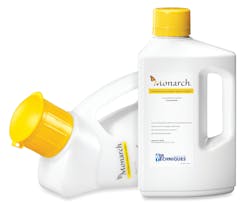Chairside Impact: Monarch CleanStream by Air Techniques
I've never given suction much thought. I mean, you turn it on, it sucks up the fluids in the patient’s mouth, and you turn it off when you’re done because it’s noisy. Then I follow whatever cleaning protocol the office had. Then COVID happened. CE courses and advertisements tell us that proper suction can help decrease or even eliminate the aerosol burden.
So now on top of all the added PPE, I’m juggling high-speed evacuation (HVE). Combine my HVE with my co-hygienist’s HVE and the dentist’s HVE and somehow it doesn’t seem to be sucking quite the way I want it to. This leads me to think it’s not helping with the aerosols, either.
After hearing a CE course by Dr. Martin Koch of Dürr Dental, I started to look into the health of our suction lines and vacuum system. I learned that most office vacuum systems were not designed with the idea that everyone would be using HVE at the same time. Air Techniques offers a free flow rate and vacuum assessment, so I called my local rep, Robbie, to set a date. One test of the flow meter showed us that while our vacuum was the right size for the office, it did not have the proper airflow needed to reduce aerosols with more than one HVE open at a time. In short, our suction wasn’t sucking!
At the time, our cleaning protocol was to mix up whatever random suction cleaner we had in an empty gallon water jug and stick the lines in once a week. There was great discussion over whether to submerge the tip or let it slurp on top. Robbie suggested we try using the Monarch CleanStream dispenser system and evacuation cleaner by Air Techniques daily. He’d come back after three months and see how our lines were doing.
I loved this philosophy. It’s similar to how I give a gingivitis patient a recall interval to start doing their maintenance and see how healthy they can get before we dive into more aggressive treatment.
The CleanStream dispenser is easy to use and once you mix it, it’s good for two rooms. Simply attach your lines to the slots in the lid and walk away. This frees you up to get another end-of-day task done. Another awesome thing about this system is that it ends the submerge/slurp debate. Using a dispenser standardizes the delivery process and prevents the vacuum from being overstressed. The dispenser allows the cleaner to enter the lines and create a vortex that actually cleans the inside of the lines as opposed to going straight through. Much like the difference between popping floss in and out of teeth and making a c-shape around each tooth. It’s actually removing the gunk!
We also learned to clean the lines from the furthest operatory from the vacuum to the closest for optimal results. Think of how you sweep your floor. You don’t start closest to the door and move to the far corner—you’d be dragging dirt everywhere.
The exciting news is that within one week, suction slowed down significantly. I know what you’re saying—why is that a good thing? Well, one check of the traps showed us a gunky, clogged mess. The lines were actually being cleaned! The main trap was filling up fast, too. We’ve only been at it for a few weeks, but the suction certainly seems to have improved.
I’ll be excited to see how we rate when Robbie comes back for our suction maintenance appointment!
About the Author

Amanda Hill, BSDH, RDH, CDIPC
Amanda Hill, BSDH, RDH, CDIPC, is an enthusiastic speaker, innovative consultant, and award-winning author who brings more than 25 years of clinical dental hygiene and education to dentistry. Recipient of ADS’s Emerging Infection Control Leader award and an active participant with the advisory board for RDH magazine, DentistryIQ, and ADS’s Infection Control in Practice Editorial Review Board and membership committee, Amanda (also known as the Waterline Warrior) strives to make topics in dentistry accurate, accessible, and fun. She can be reached at [email protected].

